ACCT 101 Assignment - Cash Flow Statement and Equity Share Capital
VerifiedAdded on 2023/06/16
|9
|1612
|217
Homework Assignment
AI Summary
This assignment solution provides a comprehensive analysis of key accounting principles. It includes a cash flow statement for Khaled Co. using the direct method, an explanation of equity share capital and its various types (authorized, unissued, issued, subscribed, called up, paid up, and reserve capital), and a discussion of treasury stock, including its impact on a company's financial position and journal entries for related transactions. The document uses definitions and examples to explain the concepts. Desklib offers a wealth of study resources, including past papers and solved assignments, to support students in mastering these and other essential accounting topics.
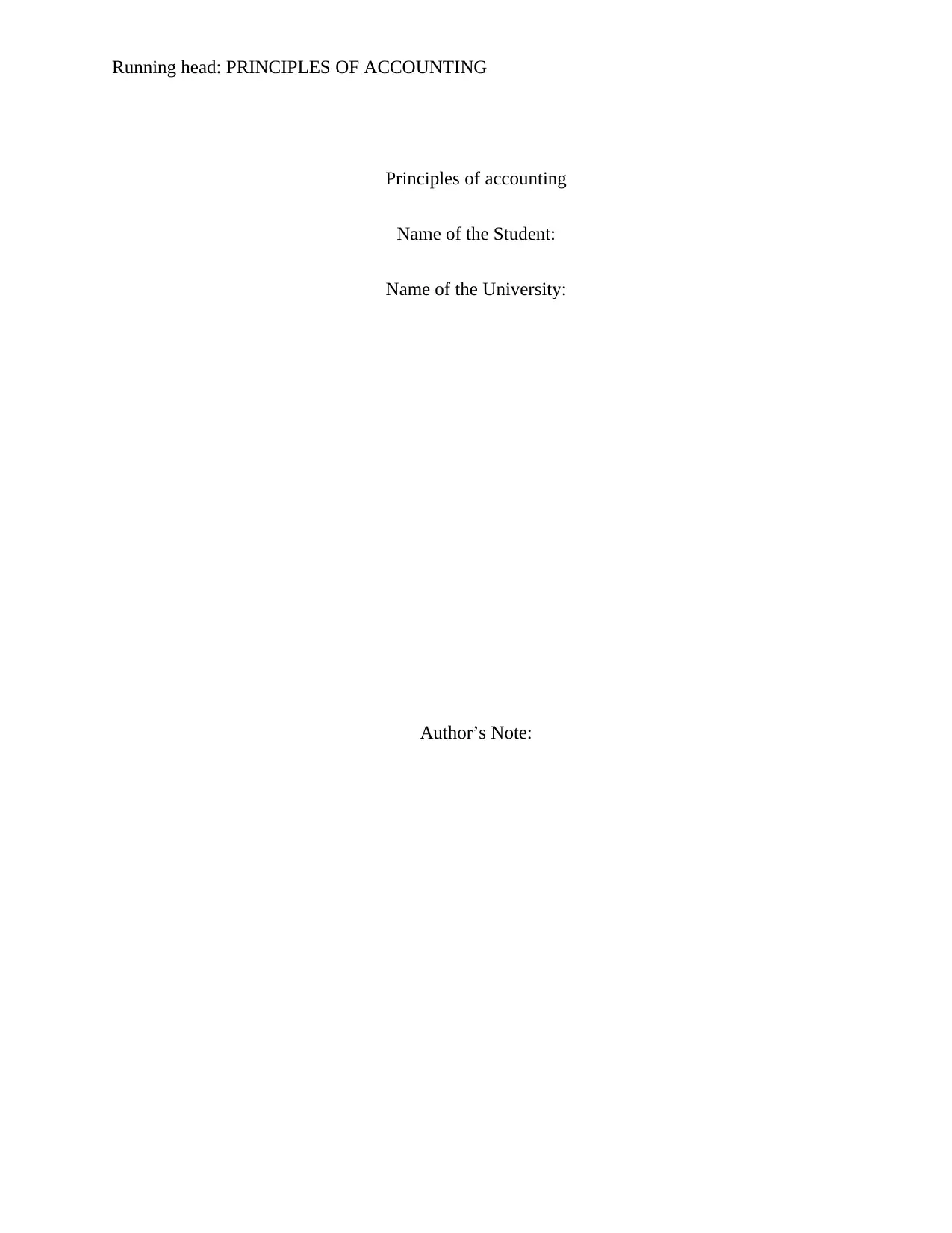
Running head: PRINCIPLES OF ACCOUNTING
Principles of accounting
Name of the Student:
Name of the University:
Author’s Note:
Principles of accounting
Name of the Student:
Name of the University:
Author’s Note:
Paraphrase This Document
Need a fresh take? Get an instant paraphrase of this document with our AI Paraphraser
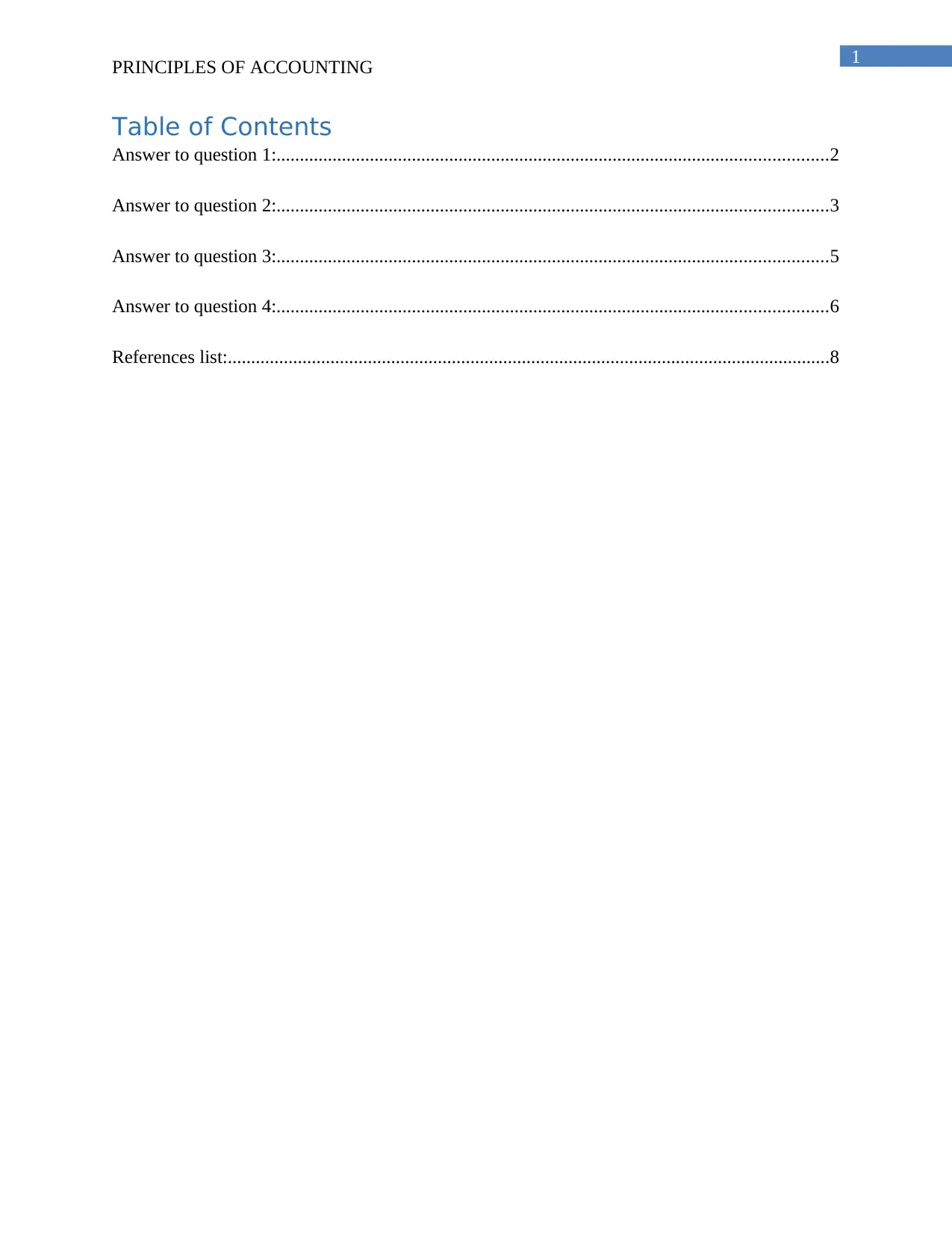
1
PRINCIPLES OF ACCOUNTING
Table of Contents
Answer to question 1:......................................................................................................................2
Answer to question 2:......................................................................................................................3
Answer to question 3:......................................................................................................................5
Answer to question 4:......................................................................................................................6
References list:.................................................................................................................................8
PRINCIPLES OF ACCOUNTING
Table of Contents
Answer to question 1:......................................................................................................................2
Answer to question 2:......................................................................................................................3
Answer to question 3:......................................................................................................................5
Answer to question 4:......................................................................................................................6
References list:.................................................................................................................................8
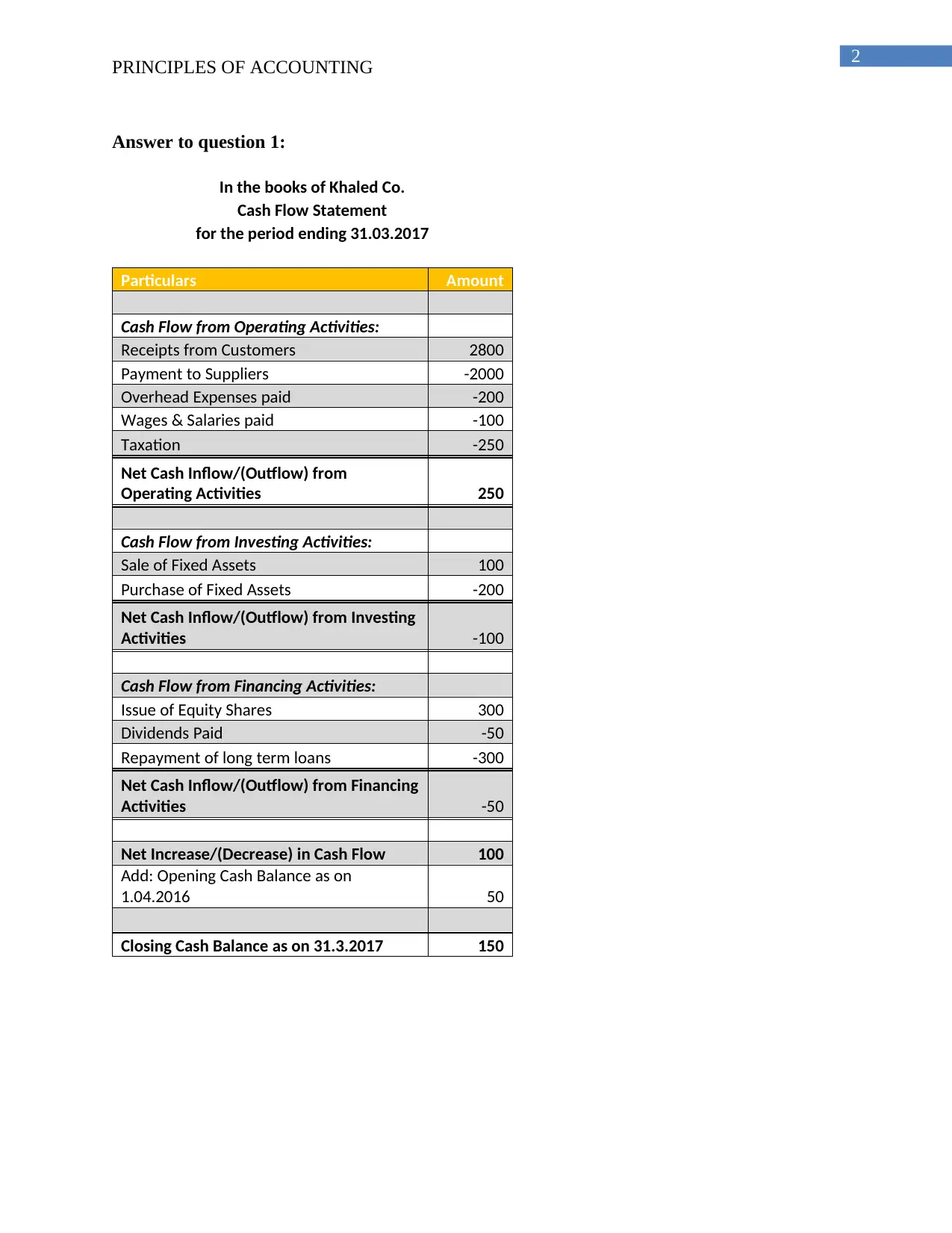
2
PRINCIPLES OF ACCOUNTING
Answer to question 1:
In the books of Khaled Co.
Cash Flow Statement
for the period ending 31.03.2017
Particulars Amount
Cash Flow from Operating Activities:
Receipts from Customers 2800
Payment to Suppliers -2000
Overhead Expenses paid -200
Wages & Salaries paid -100
Taxation -250
Net Cash Inflow/(Outflow) from
Operating Activities 250
Cash Flow from Investing Activities:
Sale of Fixed Assets 100
Purchase of Fixed Assets -200
Net Cash Inflow/(Outflow) from Investing
Activities -100
Cash Flow from Financing Activities:
Issue of Equity Shares 300
Dividends Paid -50
Repayment of long term loans -300
Net Cash Inflow/(Outflow) from Financing
Activities -50
Net Increase/(Decrease) in Cash Flow 100
Add: Opening Cash Balance as on
1.04.2016 50
Closing Cash Balance as on 31.3.2017 150
PRINCIPLES OF ACCOUNTING
Answer to question 1:
In the books of Khaled Co.
Cash Flow Statement
for the period ending 31.03.2017
Particulars Amount
Cash Flow from Operating Activities:
Receipts from Customers 2800
Payment to Suppliers -2000
Overhead Expenses paid -200
Wages & Salaries paid -100
Taxation -250
Net Cash Inflow/(Outflow) from
Operating Activities 250
Cash Flow from Investing Activities:
Sale of Fixed Assets 100
Purchase of Fixed Assets -200
Net Cash Inflow/(Outflow) from Investing
Activities -100
Cash Flow from Financing Activities:
Issue of Equity Shares 300
Dividends Paid -50
Repayment of long term loans -300
Net Cash Inflow/(Outflow) from Financing
Activities -50
Net Increase/(Decrease) in Cash Flow 100
Add: Opening Cash Balance as on
1.04.2016 50
Closing Cash Balance as on 31.3.2017 150
⊘ This is a preview!⊘
Do you want full access?
Subscribe today to unlock all pages.

Trusted by 1+ million students worldwide
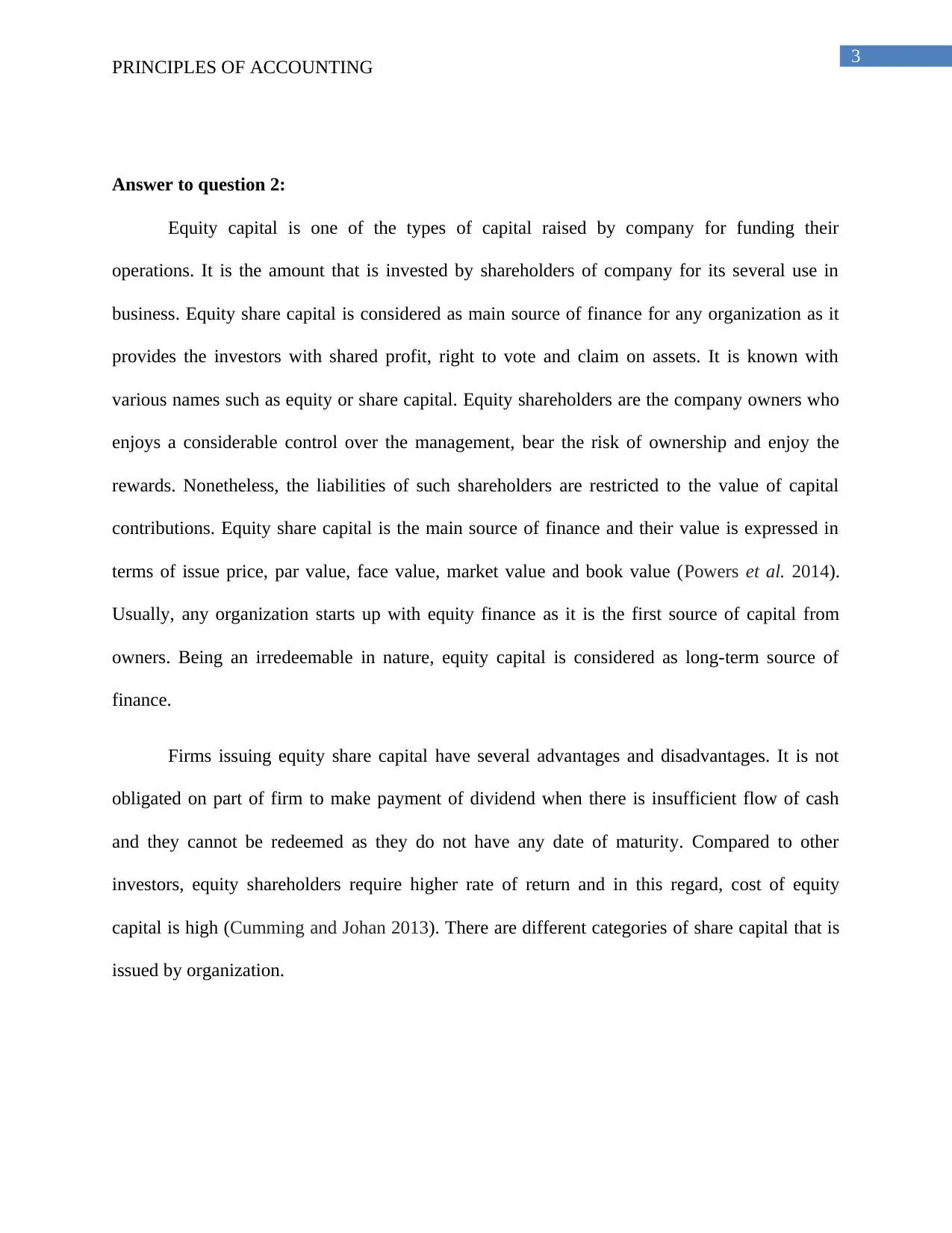
3
PRINCIPLES OF ACCOUNTING
Answer to question 2:
Equity capital is one of the types of capital raised by company for funding their
operations. It is the amount that is invested by shareholders of company for its several use in
business. Equity share capital is considered as main source of finance for any organization as it
provides the investors with shared profit, right to vote and claim on assets. It is known with
various names such as equity or share capital. Equity shareholders are the company owners who
enjoys a considerable control over the management, bear the risk of ownership and enjoy the
rewards. Nonetheless, the liabilities of such shareholders are restricted to the value of capital
contributions. Equity share capital is the main source of finance and their value is expressed in
terms of issue price, par value, face value, market value and book value (Powers et al. 2014).
Usually, any organization starts up with equity finance as it is the first source of capital from
owners. Being an irredeemable in nature, equity capital is considered as long-term source of
finance.
Firms issuing equity share capital have several advantages and disadvantages. It is not
obligated on part of firm to make payment of dividend when there is insufficient flow of cash
and they cannot be redeemed as they do not have any date of maturity. Compared to other
investors, equity shareholders require higher rate of return and in this regard, cost of equity
capital is high (Cumming and Johan 2013). There are different categories of share capital that is
issued by organization.
PRINCIPLES OF ACCOUNTING
Answer to question 2:
Equity capital is one of the types of capital raised by company for funding their
operations. It is the amount that is invested by shareholders of company for its several use in
business. Equity share capital is considered as main source of finance for any organization as it
provides the investors with shared profit, right to vote and claim on assets. It is known with
various names such as equity or share capital. Equity shareholders are the company owners who
enjoys a considerable control over the management, bear the risk of ownership and enjoy the
rewards. Nonetheless, the liabilities of such shareholders are restricted to the value of capital
contributions. Equity share capital is the main source of finance and their value is expressed in
terms of issue price, par value, face value, market value and book value (Powers et al. 2014).
Usually, any organization starts up with equity finance as it is the first source of capital from
owners. Being an irredeemable in nature, equity capital is considered as long-term source of
finance.
Firms issuing equity share capital have several advantages and disadvantages. It is not
obligated on part of firm to make payment of dividend when there is insufficient flow of cash
and they cannot be redeemed as they do not have any date of maturity. Compared to other
investors, equity shareholders require higher rate of return and in this regard, cost of equity
capital is high (Cumming and Johan 2013). There are different categories of share capital that is
issued by organization.
Paraphrase This Document
Need a fresh take? Get an instant paraphrase of this document with our AI Paraphraser
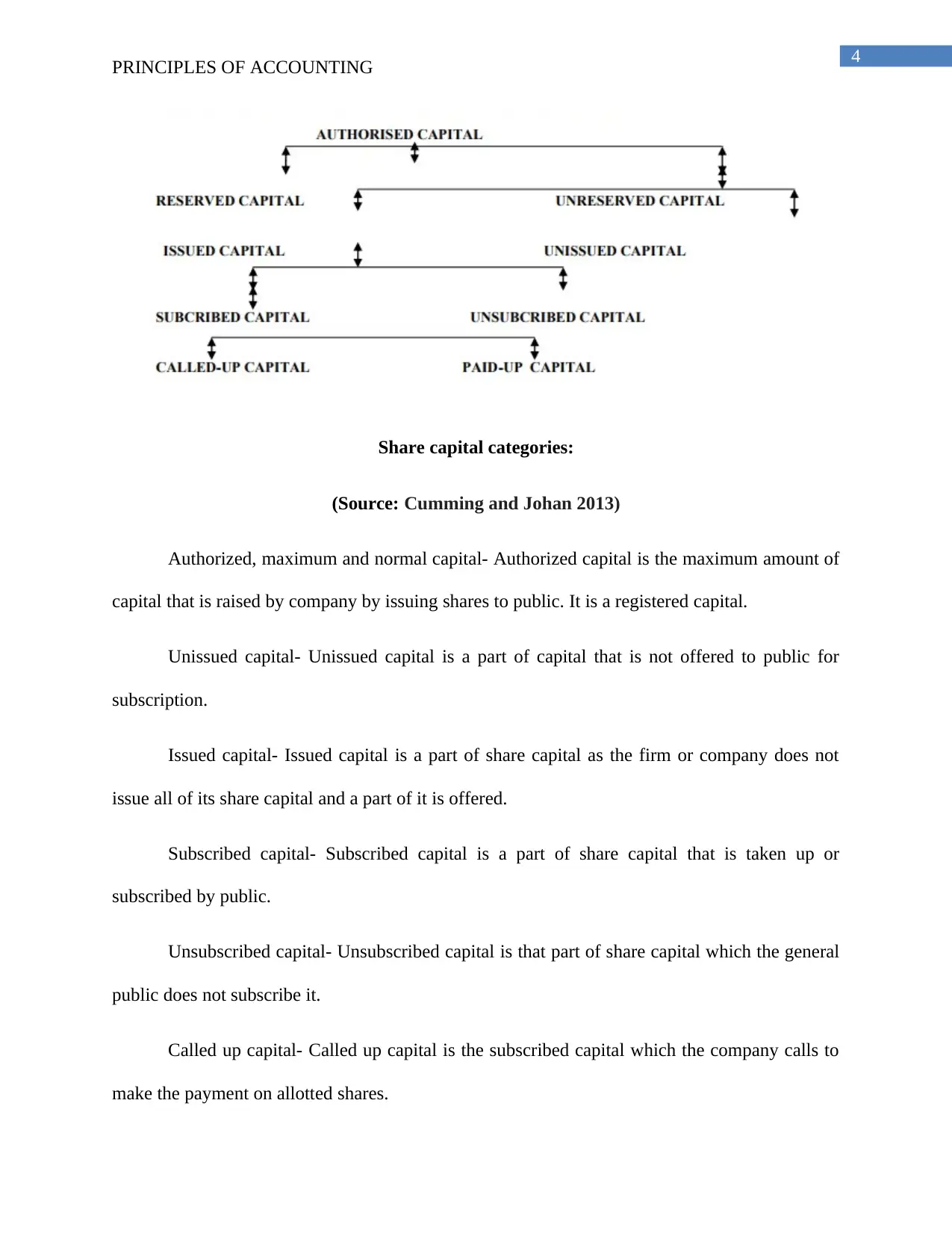
4
PRINCIPLES OF ACCOUNTING
Share capital categories:
(Source: Cumming and Johan 2013)
Authorized, maximum and normal capital- Authorized capital is the maximum amount of
capital that is raised by company by issuing shares to public. It is a registered capital.
Unissued capital- Unissued capital is a part of capital that is not offered to public for
subscription.
Issued capital- Issued capital is a part of share capital as the firm or company does not
issue all of its share capital and a part of it is offered.
Subscribed capital- Subscribed capital is a part of share capital that is taken up or
subscribed by public.
Unsubscribed capital- Unsubscribed capital is that part of share capital which the general
public does not subscribe it.
Called up capital- Called up capital is the subscribed capital which the company calls to
make the payment on allotted shares.
PRINCIPLES OF ACCOUNTING
Share capital categories:
(Source: Cumming and Johan 2013)
Authorized, maximum and normal capital- Authorized capital is the maximum amount of
capital that is raised by company by issuing shares to public. It is a registered capital.
Unissued capital- Unissued capital is a part of capital that is not offered to public for
subscription.
Issued capital- Issued capital is a part of share capital as the firm or company does not
issue all of its share capital and a part of it is offered.
Subscribed capital- Subscribed capital is a part of share capital that is taken up or
subscribed by public.
Unsubscribed capital- Unsubscribed capital is that part of share capital which the general
public does not subscribe it.
Called up capital- Called up capital is the subscribed capital which the company calls to
make the payment on allotted shares.
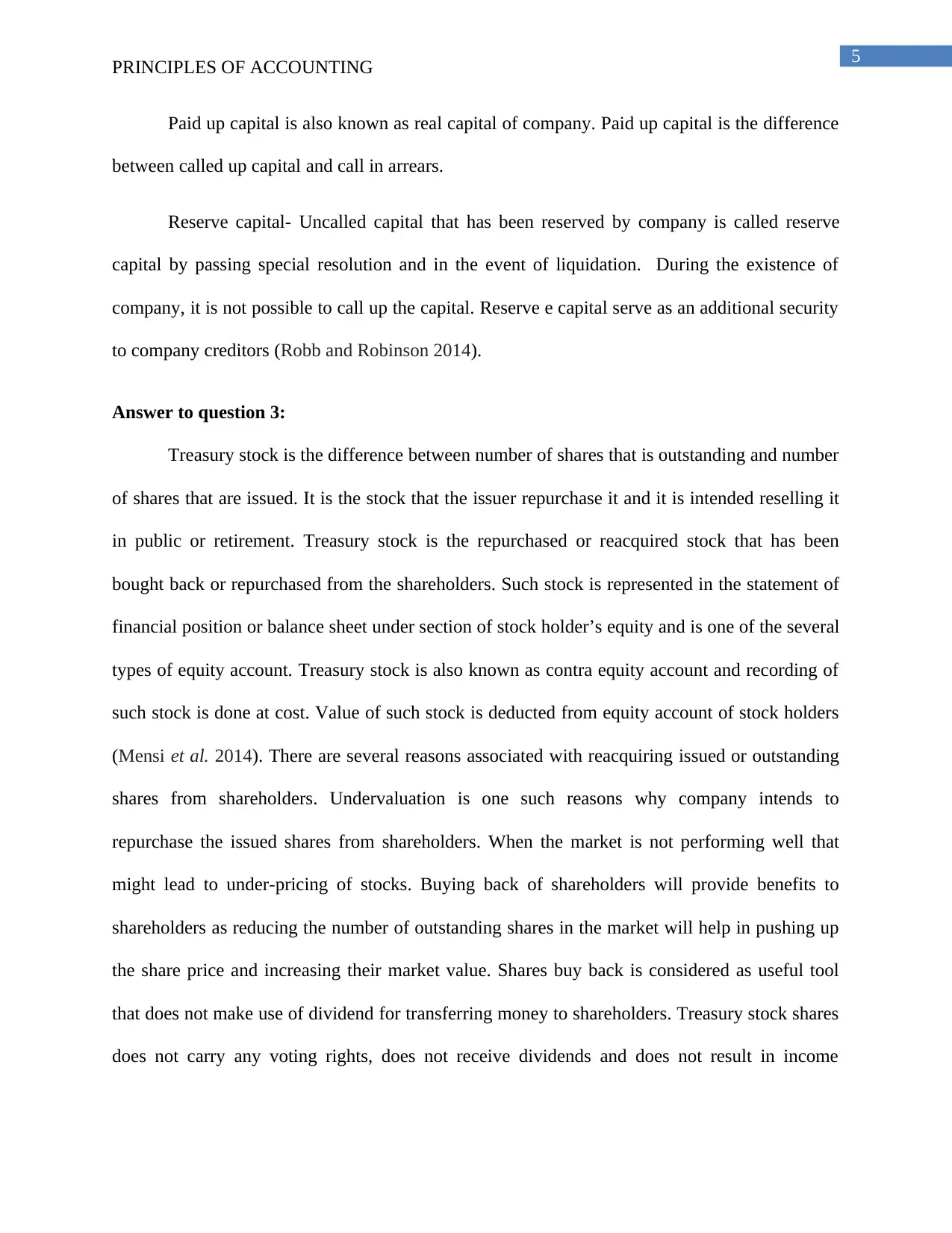
5
PRINCIPLES OF ACCOUNTING
Paid up capital is also known as real capital of company. Paid up capital is the difference
between called up capital and call in arrears.
Reserve capital- Uncalled capital that has been reserved by company is called reserve
capital by passing special resolution and in the event of liquidation. During the existence of
company, it is not possible to call up the capital. Reserve e capital serve as an additional security
to company creditors (Robb and Robinson 2014).
Answer to question 3:
Treasury stock is the difference between number of shares that is outstanding and number
of shares that are issued. It is the stock that the issuer repurchase it and it is intended reselling it
in public or retirement. Treasury stock is the repurchased or reacquired stock that has been
bought back or repurchased from the shareholders. Such stock is represented in the statement of
financial position or balance sheet under section of stock holder’s equity and is one of the several
types of equity account. Treasury stock is also known as contra equity account and recording of
such stock is done at cost. Value of such stock is deducted from equity account of stock holders
(Mensi et al. 2014). There are several reasons associated with reacquiring issued or outstanding
shares from shareholders. Undervaluation is one such reasons why company intends to
repurchase the issued shares from shareholders. When the market is not performing well that
might lead to under-pricing of stocks. Buying back of shareholders will provide benefits to
shareholders as reducing the number of outstanding shares in the market will help in pushing up
the share price and increasing their market value. Shares buy back is considered as useful tool
that does not make use of dividend for transferring money to shareholders. Treasury stock shares
does not carry any voting rights, does not receive dividends and does not result in income
PRINCIPLES OF ACCOUNTING
Paid up capital is also known as real capital of company. Paid up capital is the difference
between called up capital and call in arrears.
Reserve capital- Uncalled capital that has been reserved by company is called reserve
capital by passing special resolution and in the event of liquidation. During the existence of
company, it is not possible to call up the capital. Reserve e capital serve as an additional security
to company creditors (Robb and Robinson 2014).
Answer to question 3:
Treasury stock is the difference between number of shares that is outstanding and number
of shares that are issued. It is the stock that the issuer repurchase it and it is intended reselling it
in public or retirement. Treasury stock is the repurchased or reacquired stock that has been
bought back or repurchased from the shareholders. Such stock is represented in the statement of
financial position or balance sheet under section of stock holder’s equity and is one of the several
types of equity account. Treasury stock is also known as contra equity account and recording of
such stock is done at cost. Value of such stock is deducted from equity account of stock holders
(Mensi et al. 2014). There are several reasons associated with reacquiring issued or outstanding
shares from shareholders. Undervaluation is one such reasons why company intends to
repurchase the issued shares from shareholders. When the market is not performing well that
might lead to under-pricing of stocks. Buying back of shareholders will provide benefits to
shareholders as reducing the number of outstanding shares in the market will help in pushing up
the share price and increasing their market value. Shares buy back is considered as useful tool
that does not make use of dividend for transferring money to shareholders. Treasury stock shares
does not carry any voting rights, does not receive dividends and does not result in income
⊘ This is a preview!⊘
Do you want full access?
Subscribe today to unlock all pages.

Trusted by 1+ million students worldwide
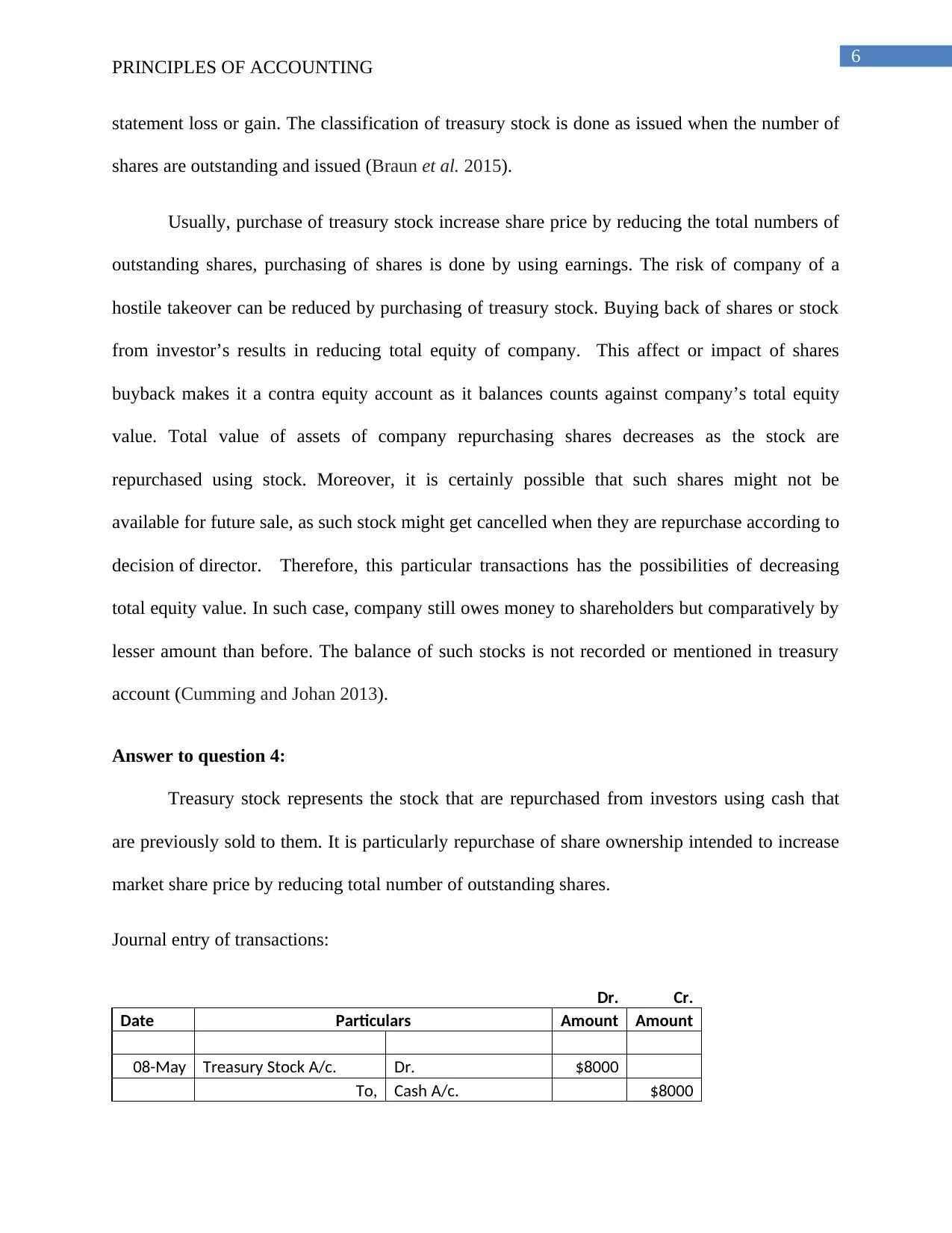
6
PRINCIPLES OF ACCOUNTING
statement loss or gain. The classification of treasury stock is done as issued when the number of
shares are outstanding and issued (Braun et al. 2015).
Usually, purchase of treasury stock increase share price by reducing the total numbers of
outstanding shares, purchasing of shares is done by using earnings. The risk of company of a
hostile takeover can be reduced by purchasing of treasury stock. Buying back of shares or stock
from investor’s results in reducing total equity of company. This affect or impact of shares
buyback makes it a contra equity account as it balances counts against company’s total equity
value. Total value of assets of company repurchasing shares decreases as the stock are
repurchased using stock. Moreover, it is certainly possible that such shares might not be
available for future sale, as such stock might get cancelled when they are repurchase according to
decision of director. Therefore, this particular transactions has the possibilities of decreasing
total equity value. In such case, company still owes money to shareholders but comparatively by
lesser amount than before. The balance of such stocks is not recorded or mentioned in treasury
account (Cumming and Johan 2013).
Answer to question 4:
Treasury stock represents the stock that are repurchased from investors using cash that
are previously sold to them. It is particularly repurchase of share ownership intended to increase
market share price by reducing total number of outstanding shares.
Journal entry of transactions:
Dr. Cr.
Date Particulars Amount Amount
08-May Treasury Stock A/c. Dr. $8000
To, Cash A/c. $8000
PRINCIPLES OF ACCOUNTING
statement loss or gain. The classification of treasury stock is done as issued when the number of
shares are outstanding and issued (Braun et al. 2015).
Usually, purchase of treasury stock increase share price by reducing the total numbers of
outstanding shares, purchasing of shares is done by using earnings. The risk of company of a
hostile takeover can be reduced by purchasing of treasury stock. Buying back of shares or stock
from investor’s results in reducing total equity of company. This affect or impact of shares
buyback makes it a contra equity account as it balances counts against company’s total equity
value. Total value of assets of company repurchasing shares decreases as the stock are
repurchased using stock. Moreover, it is certainly possible that such shares might not be
available for future sale, as such stock might get cancelled when they are repurchase according to
decision of director. Therefore, this particular transactions has the possibilities of decreasing
total equity value. In such case, company still owes money to shareholders but comparatively by
lesser amount than before. The balance of such stocks is not recorded or mentioned in treasury
account (Cumming and Johan 2013).
Answer to question 4:
Treasury stock represents the stock that are repurchased from investors using cash that
are previously sold to them. It is particularly repurchase of share ownership intended to increase
market share price by reducing total number of outstanding shares.
Journal entry of transactions:
Dr. Cr.
Date Particulars Amount Amount
08-May Treasury Stock A/c. Dr. $8000
To, Cash A/c. $8000
Paraphrase This Document
Need a fresh take? Get an instant paraphrase of this document with our AI Paraphraser
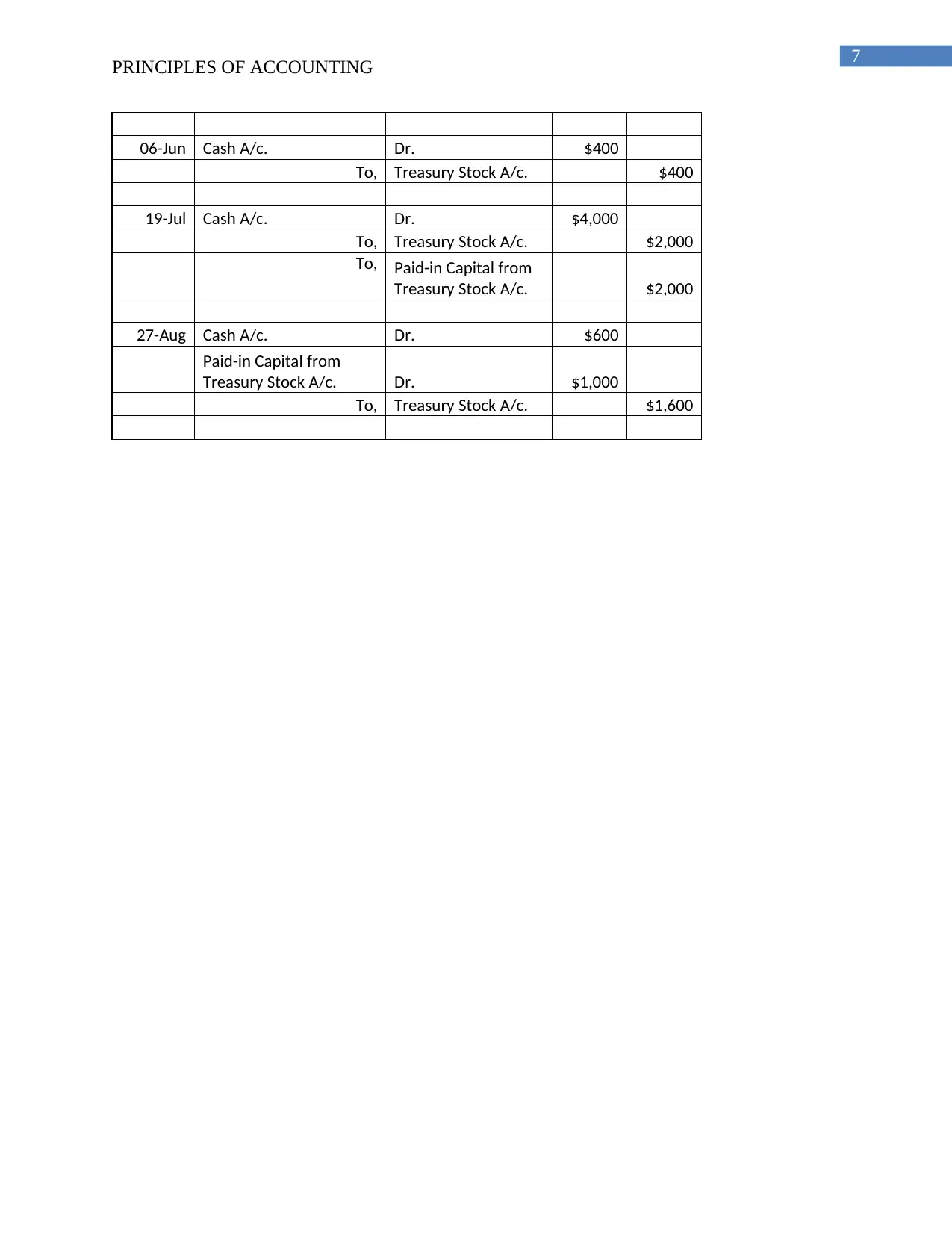
7
PRINCIPLES OF ACCOUNTING
06-Jun Cash A/c. Dr. $400
To, Treasury Stock A/c. $400
19-Jul Cash A/c. Dr. $4,000
To, Treasury Stock A/c. $2,000
To, Paid-in Capital from
Treasury Stock A/c. $2,000
27-Aug Cash A/c. Dr. $600
Paid-in Capital from
Treasury Stock A/c. Dr. $1,000
To, Treasury Stock A/c. $1,600
PRINCIPLES OF ACCOUNTING
06-Jun Cash A/c. Dr. $400
To, Treasury Stock A/c. $400
19-Jul Cash A/c. Dr. $4,000
To, Treasury Stock A/c. $2,000
To, Paid-in Capital from
Treasury Stock A/c. $2,000
27-Aug Cash A/c. Dr. $600
Paid-in Capital from
Treasury Stock A/c. Dr. $1,000
To, Treasury Stock A/c. $1,600
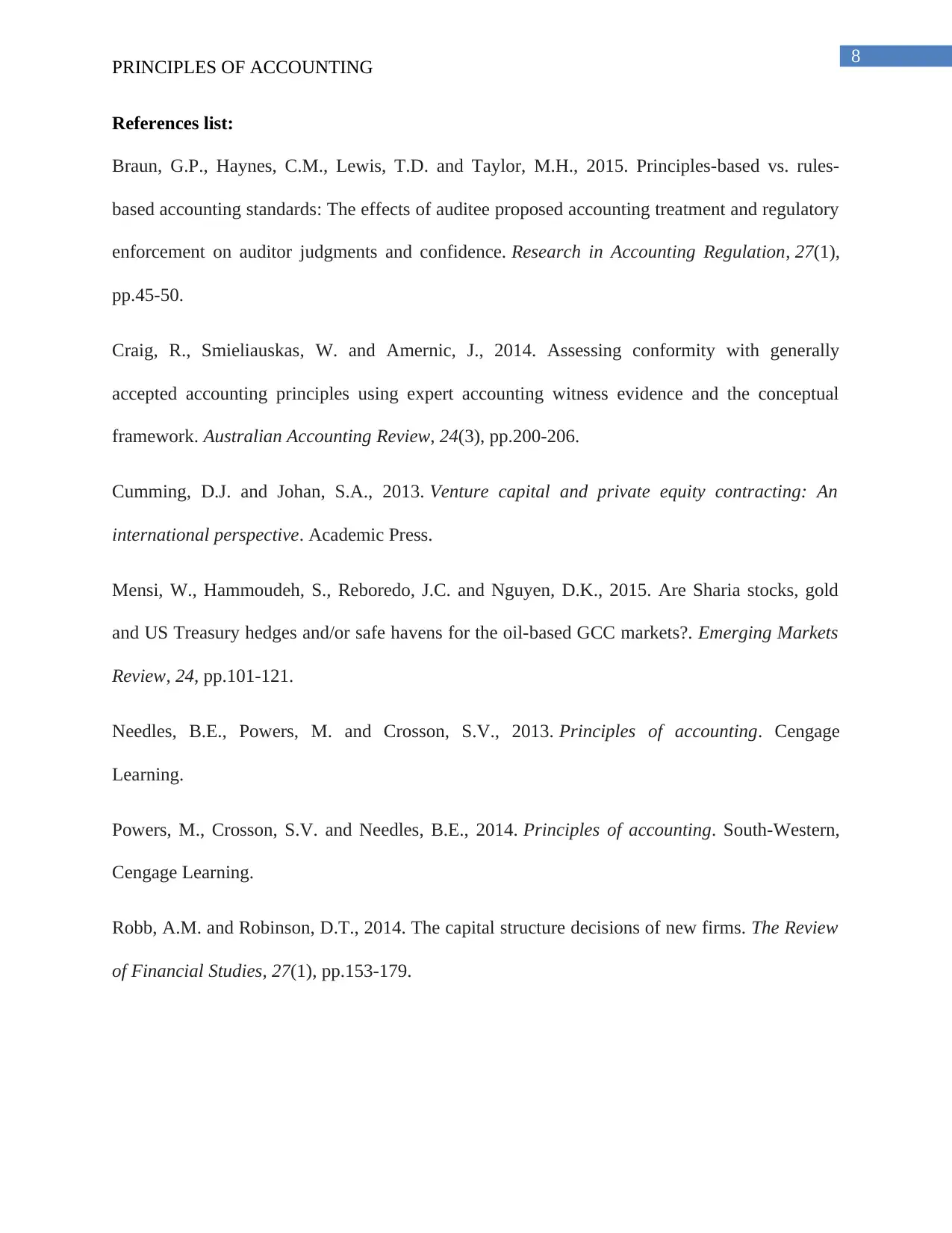
8
PRINCIPLES OF ACCOUNTING
References list:
Braun, G.P., Haynes, C.M., Lewis, T.D. and Taylor, M.H., 2015. Principles-based vs. rules-
based accounting standards: The effects of auditee proposed accounting treatment and regulatory
enforcement on auditor judgments and confidence. Research in Accounting Regulation, 27(1),
pp.45-50.
Craig, R., Smieliauskas, W. and Amernic, J., 2014. Assessing conformity with generally
accepted accounting principles using expert accounting witness evidence and the conceptual
framework. Australian Accounting Review, 24(3), pp.200-206.
Cumming, D.J. and Johan, S.A., 2013. Venture capital and private equity contracting: An
international perspective. Academic Press.
Mensi, W., Hammoudeh, S., Reboredo, J.C. and Nguyen, D.K., 2015. Are Sharia stocks, gold
and US Treasury hedges and/or safe havens for the oil-based GCC markets?. Emerging Markets
Review, 24, pp.101-121.
Needles, B.E., Powers, M. and Crosson, S.V., 2013. Principles of accounting. Cengage
Learning.
Powers, M., Crosson, S.V. and Needles, B.E., 2014. Principles of accounting. South-Western,
Cengage Learning.
Robb, A.M. and Robinson, D.T., 2014. The capital structure decisions of new firms. The Review
of Financial Studies, 27(1), pp.153-179.
PRINCIPLES OF ACCOUNTING
References list:
Braun, G.P., Haynes, C.M., Lewis, T.D. and Taylor, M.H., 2015. Principles-based vs. rules-
based accounting standards: The effects of auditee proposed accounting treatment and regulatory
enforcement on auditor judgments and confidence. Research in Accounting Regulation, 27(1),
pp.45-50.
Craig, R., Smieliauskas, W. and Amernic, J., 2014. Assessing conformity with generally
accepted accounting principles using expert accounting witness evidence and the conceptual
framework. Australian Accounting Review, 24(3), pp.200-206.
Cumming, D.J. and Johan, S.A., 2013. Venture capital and private equity contracting: An
international perspective. Academic Press.
Mensi, W., Hammoudeh, S., Reboredo, J.C. and Nguyen, D.K., 2015. Are Sharia stocks, gold
and US Treasury hedges and/or safe havens for the oil-based GCC markets?. Emerging Markets
Review, 24, pp.101-121.
Needles, B.E., Powers, M. and Crosson, S.V., 2013. Principles of accounting. Cengage
Learning.
Powers, M., Crosson, S.V. and Needles, B.E., 2014. Principles of accounting. South-Western,
Cengage Learning.
Robb, A.M. and Robinson, D.T., 2014. The capital structure decisions of new firms. The Review
of Financial Studies, 27(1), pp.153-179.
⊘ This is a preview!⊘
Do you want full access?
Subscribe today to unlock all pages.

Trusted by 1+ million students worldwide
1 out of 9
Related Documents
Your All-in-One AI-Powered Toolkit for Academic Success.
+13062052269
info@desklib.com
Available 24*7 on WhatsApp / Email
![[object Object]](/_next/static/media/star-bottom.7253800d.svg)
Unlock your academic potential
Copyright © 2020–2025 A2Z Services. All Rights Reserved. Developed and managed by ZUCOL.





